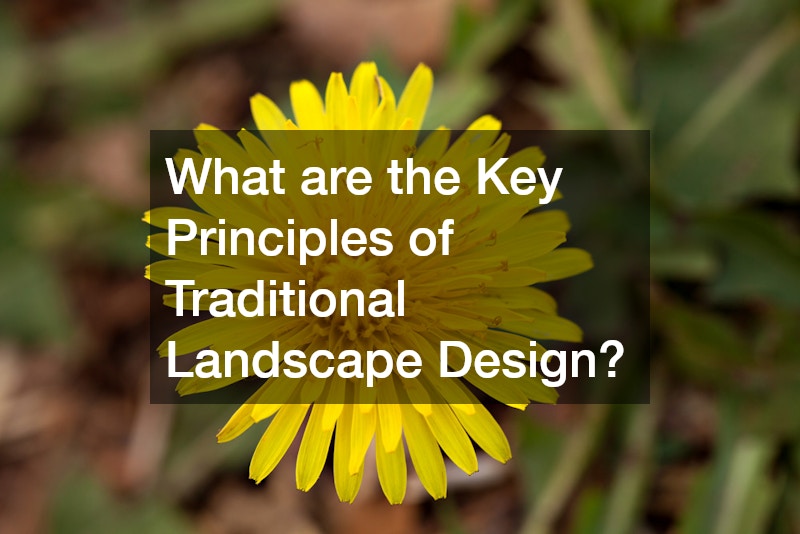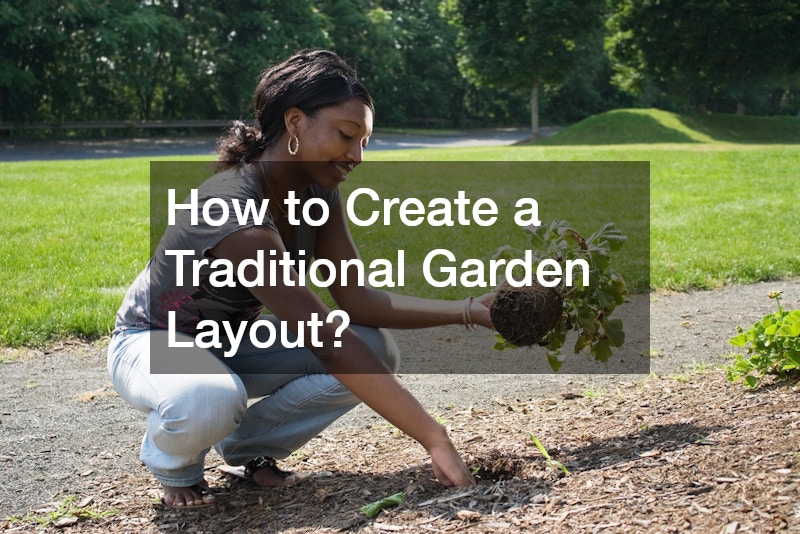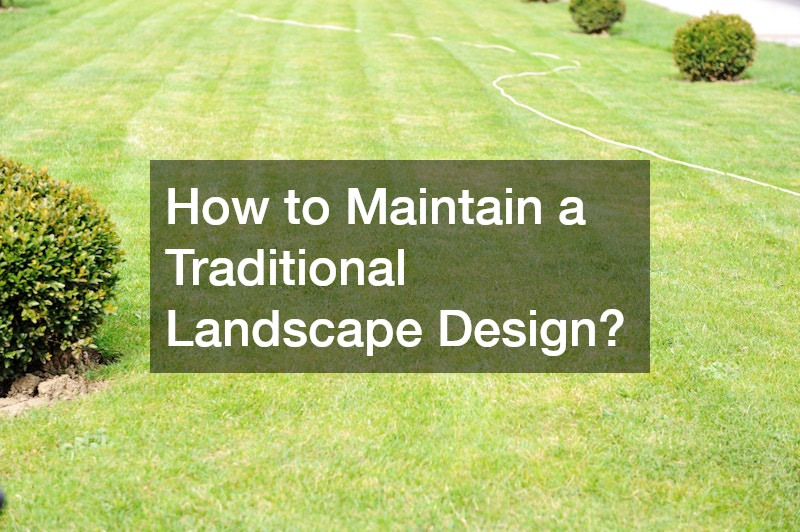Traditional landscape design has stood the test of time, known for its timeless elegance, balance, and harmonious integration with the natural environment. Unlike more modern or eclectic styles, traditional landscaping relies on symmetry, well-planned layouts, and classic design principles to create outdoor spaces that are both functional and aesthetically pleasing. Whether adorning a stately home or enhancing a modest garden, traditional landscaping elements bring a sense of calm, order, and enduring charm to any setting.
A well-executed traditional landscape often involves a wide range of services and materials, including the work of a skilled landscape contractor, quality landscaping dirt for proper grading, and expert hardscape installation. From selecting plants at a tree nursery to sourcing stone from a trusted masonry supplier, each detail plays a role in crafting a beautiful and lasting garden environment.
What are the Key Principles of Traditional Landscape Design?

Balance and Symmetry
One of the hallmarks of traditional landscape design is its emphasis on balance and symmetry. This approach involves mirroring elements on either side of a central axis, creating a sense of order and stability. Whether it’s matching plantings on each side of a walkway or flanking an entrance with identical urns or shrubs, symmetry helps guide the eye and establishes a rhythm in the landscape. Symmetry can also extend to structural elements, such as placing identical pergolas or installing a patio enclosure that aligns with the home’s architectural symmetry.
Unity and Harmony
Unity and harmony refer to the cohesive blending of elements within the landscape. In traditional design, this is achieved through repetition of plant types, consistent use of materials, and coordinated color schemes. Everything from the hardscape installation to the plant palette should feel connected, working together to convey a unified aesthetic. Collaborating with a landscape contractor helps ensure all elements flow together seamlessly.
Scale and Proportion
Maintaining appropriate scale and proportion is essential in creating a balanced outdoor environment. This means selecting plants and structures that are appropriately sized in relation to the home and other landscape elements. A large custom paver patio should be scaled to complement the size of the lawn and house, while a hot tub should be placed thoughtfully within the design, neither dominating nor disappearing into the landscape.
Transition and Sequence
Smooth transitions between different areas of the garden ensure a seamless experience. This involves gradual changes in plant height, texture, and color, as well as thoughtful placement of walkways, gates, and structures. Traditional gardens often lead visitors on a journey, with focal points and framed views enhancing the experience at every turn. For example, a winding pathway leading to a deck builder–crafted platform can create a perfect transition between formal and informal garden spaces.
Simplicity and Elegance
Simplicity is a cornerstone of traditional design. Rather than overwhelming the senses, traditional landscapes aim for restrained elegance. Clean lines, classic forms, and well-defined spaces combine to create an atmosphere of timeless grace. Furniture, such as aluminum commercial outdoor furniture, can blend functionality with understated sophistication, maintaining the garden’s classic appeal.
How to Choose the Right Plants for a Traditional Landscape?
Understanding Climate and Soil Types
Choosing the right plants starts with an understanding of the local climate and soil conditions. Selecting species that thrive naturally in your region reduces maintenance and improves the health of the landscape. Soil tests can help determine pH and nutrient levels, guiding appropriate plant selection and amendments. High-quality landscaping dirt, sourced locally or from a reputable masonry supplier, supports plant health and structural integrity.
Incorporating Native Plants
Native plants offer numerous advantages in traditional landscape design. Not only do they support local biodiversity, but they also tend to require less water, fertilizer, and pest control. Many native plants have a subtle beauty that fits well with traditional aesthetics. Sourcing these from a specialized tree nursery ensures access to healthy, region-appropriate selections.
Choosing Perennials and Annuals
Perennials form the backbone of traditional plantings, returning year after year and providing structure throughout the seasons. Annuals can be used to introduce seasonal color and variety. In combination, they create dynamic and enduring planting schemes. A landscape contractor can help develop a planting plan that maximizes both longevity and seasonal impact.
Trees and Shrubs for Structure
Trees and shrubs add height, form, and permanence to a traditional garden. Boxwoods, holly, yew, and flowering shrubs like hydrangeas are often used for their classic appeal and architectural qualities. They serve as borders, focal points, and background plantings. Visiting a tree nursery offers the opportunity to select well-established specimens that provide immediate visual impact.
Seasonal Color and Blooms
A well-designed traditional landscape features interest in all seasons. This is achieved through a selection of plants that bloom at different times, offer fall foliage, or retain winter form. Seasonal displays add depth and invite visitors to return throughout the year. Consulting with a landscape contractor helps ensure a balanced and ever-changing color palette.
What are Traditional Hardscape Features?
Pathways and Walkways
Pathways guide movement and define spaces in the landscape. In traditional design, materials such as brick, gravel, and natural stone are commonly used to create inviting, durable walkways. Their placement should feel intuitive, leading from one garden area to another with purpose and elegance. These elements are often sourced through a masonry supplier to ensure quality and authenticity.
Patios and Terraces
Outdoor living areas like patios and terraces are integral to traditional landscapes. These spaces provide comfortable settings for entertaining or relaxing and are often constructed from natural stone or as a custom paver patio to complement the overall aesthetic. Coordinating with a deck builder ensures seamless integration with adjacent structures and allows for the addition of hot tubs or patio enclosures for year-round enjoyment.
Retaining Walls and Borders
Retaining walls prevent erosion and manage elevation changes while also serving as strong visual features. Traditional walls are typically made from natural stone or brick, paired with lush plantings to soften their appearance. Using materials from a reliable masonry supplier ensures durability and aesthetic consistency.
Fountains and Water Features
Water features are classic elements in traditional design, adding tranquility and a sensory dimension. Fountains, birdbaths, and small reflecting pools can become focal points or quiet retreats. Proper planning and installation by a landscape contractor can help integrate these features naturally into the garden.
Gazebos and Pergolas
Structures such as gazebos and pergolas provide shade, shelter, and architectural interest. These features anchor the garden, often serving as gathering spots or quiet nooks. Collaborating with a deck builder ensures these structures are both functional and visually cohesive with the rest of the landscape.
How to Create a Traditional Garden Layout?

The Formal Garden Layout
Formal gardens feature symmetrical arrangements, axial paths, and geometric planting beds. Inspired by European styles, these gardens rely on clipped hedges, central focal points, and well-defined spaces. Incorporating a patio enclosure or custom paver patio can enhance the structured layout and provide space for furniture and outdoor living.
The Cottage Garden Style
Cottage gardens offer a more relaxed, romantic take on traditional design. They are characterized by dense, mixed plantings of perennials, herbs, and vegetables, often spilling over paths and borders. Thoughtful hardscape installation ensures these gardens retain structure without losing their informal charm.
The Potager or Kitchen Garden
A potager is a beautifully organized kitchen garden that blends functionality with aesthetic appeal. It includes vegetables, herbs, and edible flowers laid out in ornamental patterns. Raised beds built by a deck builder and paths lined with materials from a masonry supplier can elevate both function and form.
Incorporating a Lawn
Lawn areas play an important role in traditional landscapes, offering open space and visual contrast to denser plantings. Proper grading using quality landscaping dirt ensures healthy turf and effective drainage.
Designing with Views and Vistas
Traditional design often incorporates planned views and focal points. Whether it’s a distant tree, a garden statue, or a framed vista through a hedge, these visual cues draw the eye and invite movement through the landscape. Placement of hot tubs, pergolas, or water features can be used to highlight or anchor these views.
What Role Do Colors Play in Traditional Landscape Design?
Creating a Color Palette
Color selection in traditional design is intentional and restrained. A harmonious palette ensures a cohesive look throughout the seasons. Working with a landscape contractor can help you select plants and materials that reflect your vision while maintaining balance.
The Use of Neutral Colors
Neutral tones such as white, cream, and soft grays are staples of traditional gardens. These colors enhance the form of plants and structures, creating a calm and timeless atmosphere.
Accentuating with Bold Colors
While traditional gardens typically favor subtlety, bold colors can be used sparingly to create focal points or seasonal impact. Deep reds, purples, and blues provide rich accents, especially in planters or near seating areas furnished with aluminum commercial outdoor furniture.
Seasonal Color Changes
Designing for seasonal color change adds depth and interest. Spring bulbs, summer perennials, autumn foliage, and winter berries ensure that the landscape evolves throughout the year.
Color and Plant Combinations
Color is often used to group compatible plants, enhancing their visual appeal. Repetition of color throughout the garden adds continuity and flow.
How to Use Lighting in Traditional Landscape Design?
Types of Landscape Lighting
Traditional landscape lighting includes path lights, uplights, downlights, and wall-mounted fixtures. These are often styled to complement the classic architecture of the home and garden.
Highlighting Key Features
Lighting can emphasize focal points such as statues, fountains, or trees. A landscape contractor can help plan lighting to highlight these features effectively.
Creating Mood with Lighting
Lighting plays a role in setting the garden’s mood. Warm-toned lights create a cozy, inviting atmosphere, especially around hot tubs or seating areas.
Energy-Efficient Lighting Options
Energy-efficient options like LED or solar-powered lights can reduce energy consumption while maintaining aesthetics.
Safety and Pathway Illumination
Illuminating walkways and steps enhances both safety and usability. These lights should blend with the landscape while ensuring visibility.
What are the Benefits of Traditional Landscape Design?

Timeless Appeal and Aesthetics
Traditional design never goes out of style. Its classic forms and harmonious elements offer enduring beauty that transcends trends.
Increasing Property Value
A well-designed landscape, supported by expert hardscape installation and quality materials from a masonry supplier, can significantly increase property value.
Environmental Impact
Using native plants, proper landscaping dirt, and sustainable practices reduces the environmental impact and supports local ecosystems.
Promoting Outdoor Living
Traditional landscapes are designed for enjoyment. Whether dining under a pergola, relaxing in a hot tub, or lounging on aluminum commercial outdoor furniture, these spaces encourage people to spend more time outdoors.
Low Maintenance Strategies
Choosing hardy plants and smart design practices can result in a beautiful, low-maintenance traditional landscape.
How to Incorporate Water Features in a Traditional Landscape?
Types of Water Features
Common water features include fountains, birdbaths, and small ponds. These elements are often designed to complement formal layouts.
Placement and Design Considerations
Water features should be visible and accessible. A landscape contractor can help determine the best placement based on existing structures and views.
Water Feature Maintenance
Regular cleaning and care ensure that water features remain beautiful and functional.
Enhancing Biodiversity
Water features attract birds, insects, and small wildlife, enriching the garden ecosystem.
Integrating Water and Plant Design
Plantings around water features help them blend into the garden and provide a more natural appearance.
What are the Best Materials for Traditional Landscape Design?
Natural Stone vs. Manufactured Materials
Natural stone offers authenticity and elegance, making it ideal for walkways, patios, and walls. A reputable masonry supplier can help you find materials that fit both your budget and design.
Wood and Timber Elements
Wood adds warmth and charm, perfect for structures built by a skilled deck builder.
Metalwork and Iron Features
Wrought iron gates, arbors, and furniture bring a vintage touch to traditional designs.
Brick and Masonry Uses
Brick offers historic charm and visual texture. A quality masonry supplier ensures you get consistent, durable materials.
Sustainable Material Choices
Choosing sustainably sourced or recycled materials reduces your environmental footprint while maintaining classic appeal.
How to Maintain a Traditional Landscape Design?

Seasonal Maintenance Tasks
Each season has its tasks—spring planting, summer irrigation, fall cleanup, and winter prep.
Pruning and Trimming Techniques
Proper trimming maintains structure and promotes healthy growth. A landscape contractor can advise on best practices.
Pest and Disease Management
Integrated pest management and healthy soil help reduce the risk of problems.
Watering and Irrigation Systems
Efficient irrigation keeps your plants healthy while conserving water.
Soil Health and Fertilization
Regular additions of compost and organic matter maintain fertile soil, especially when paired with high-quality landscaping dirt.
Closing Thoughts
Traditional landscape design continues to enchant homeowners with its classic beauty, thoughtful structure, and harmonious blend of form and function. From the skilled hands of a deck builder creating custom structures to the careful selection of trees at a local tree nursery, every detail contributes to a lasting impression. By incorporating high-quality materials from a masonry supplier, installing aluminum commercial outdoor furniture for enduring comfort, and relying on expert hardscape installation, you can create a space that feels both luxurious and grounded in tradition. Let your landscape contractor help bring your vision to life—resulting in an outdoor space that not only looks stunning but stands the test of time.



